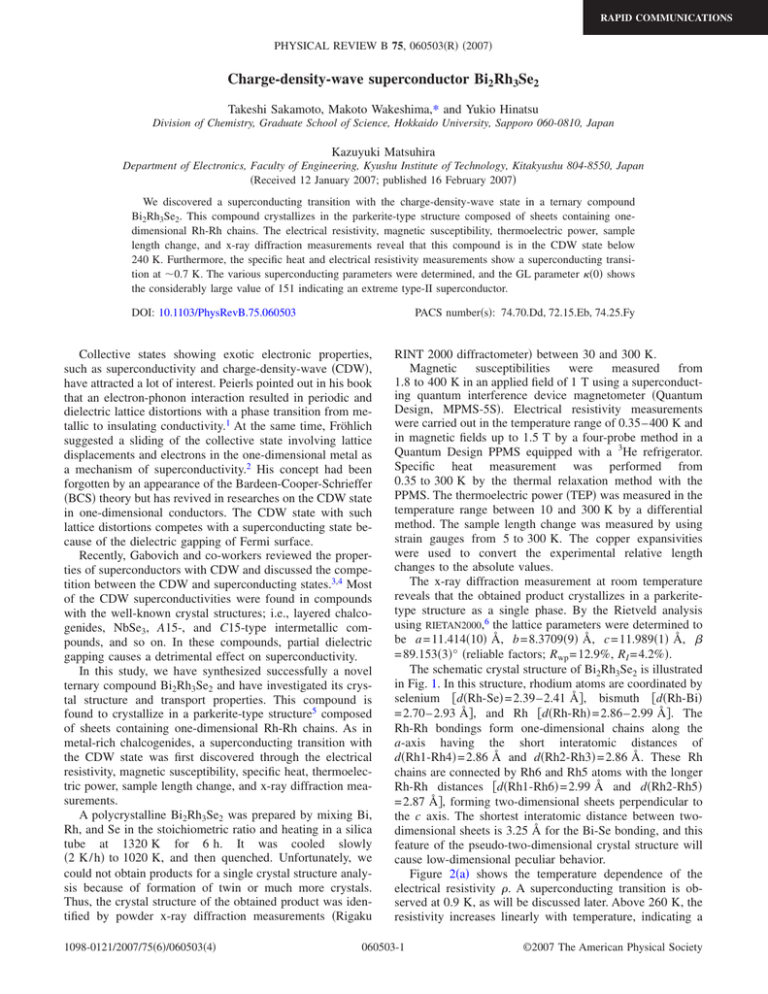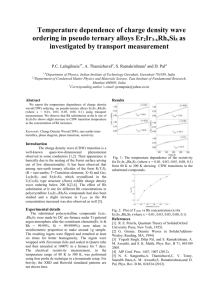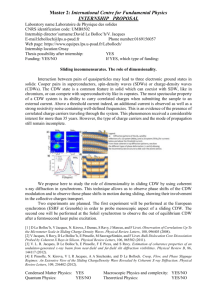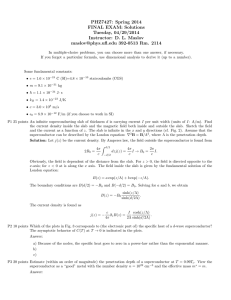Charge-density-wave superconductor Bi2Rh3Se2
advertisement

RAPID COMMUNICATIONS PHYSICAL REVIEW B 75, 060503共R兲 共2007兲 Charge-density-wave superconductor Bi2Rh3Se2 Takeshi Sakamoto, Makoto Wakeshima,* and Yukio Hinatsu Division of Chemistry, Graduate School of Science, Hokkaido University, Sapporo 060-0810, Japan Kazuyuki Matsuhira Department of Electronics, Faculty of Engineering, Kyushu Institute of Technology, Kitakyushu 804-8550, Japan 共Received 12 January 2007; published 16 February 2007兲 We discovered a superconducting transition with the charge-density-wave state in a ternary compound Bi2Rh3Se2. This compound crystallizes in the parkerite-type structure composed of sheets containing onedimensional Rh-Rh chains. The electrical resistivity, magnetic susceptibility, thermoelectric power, sample length change, and x-ray diffraction measurements reveal that this compound is in the CDW state below 240 K. Furthermore, the specific heat and electrical resistivity measurements show a superconducting transition at ⬃0.7 K. The various superconducting parameters were determined, and the GL parameter 共0兲 shows the considerably large value of 151 indicating an extreme type-II superconductor. DOI: 10.1103/PhysRevB.75.060503 PACS number共s兲: 74.70.Dd, 72.15.Eb, 74.25.Fy Collective states showing exotic electronic properties, such as superconductivity and charge-density-wave 共CDW兲, have attracted a lot of interest. Peierls pointed out in his book that an electron-phonon interaction resulted in periodic and dielectric lattice distortions with a phase transition from metallic to insulating conductivity.1 At the same time, Fröhlich suggested a sliding of the collective state involving lattice displacements and electrons in the one-dimensional metal as a mechanism of superconductivity.2 His concept had been forgotten by an appearance of the Bardeen-Cooper-Schrieffer 共BCS兲 theory but has revived in researches on the CDW state in one-dimensional conductors. The CDW state with such lattice distortions competes with a superconducting state because of the dielectric gapping of Fermi surface. Recently, Gabovich and co-workers reviewed the properties of superconductors with CDW and discussed the competition between the CDW and superconducting states.3,4 Most of the CDW superconductivities were found in compounds with the well-known crystal structures; i.e., layered chalcogenides, NbSe3, A15-, and C15-type intermetallic compounds, and so on. In these compounds, partial dielectric gapping causes a detrimental effect on superconductivity. In this study, we have synthesized successfully a novel ternary compound Bi2Rh3Se2 and have investigated its crystal structure and transport properties. This compound is found to crystallize in a parkerite-type structure5 composed of sheets containing one-dimensional Rh-Rh chains. As in metal-rich chalcogenides, a superconducting transition with the CDW state was first discovered through the electrical resistivity, magnetic susceptibility, specific heat, thermoelectric power, sample length change, and x-ray diffraction measurements. A polycrystalline Bi2Rh3Se2 was prepared by mixing Bi, Rh, and Se in the stoichiometric ratio and heating in a silica tube at 1320 K for 6 h. It was cooled slowly 共2 K / h兲 to 1020 K, and then quenched. Unfortunately, we could not obtain products for a single crystal structure analysis because of formation of twin or much more crystals. Thus, the crystal structure of the obtained product was identified by powder x-ray diffraction measurements 共Rigaku 1098-0121/2007/75共6兲/060503共4兲 RINT 2000 diffractometer兲 between 30 and 300 K. Magnetic susceptibilities were measured from 1.8 to 400 K in an applied field of 1 T using a superconducting quantum interference device magnetometer 共Quantum Design, MPMS-5S兲. Electrical resistivity measurements were carried out in the temperature range of 0.35– 400 K and in magnetic fields up to 1.5 T by a four-probe method in a Quantum Design PPMS equipped with a 3He refrigerator. Specific heat measurement was performed from 0.35 to 300 K by the thermal relaxation method with the PPMS. The thermoelectric power 共TEP兲 was measured in the temperature range between 10 and 300 K by a differential method. The sample length change was measured by using strain gauges from 5 to 300 K. The copper expansivities were used to convert the experimental relative length changes to the absolute values. The x-ray diffraction measurement at room temperature reveals that the obtained product crystallizes in a parkeritetype structure as a single phase. By the Rietveld analysis using RIETAN2000,6 the lattice parameters were determined to be a = 11.414共10兲 Å, b = 8.3709共9兲 Å, c = 11.989共1兲 Å,  = 89.153共3兲° 共reliable factors; Rwp = 12.9%, RI = 4.2%兲. The schematic crystal structure of Bi2Rh3Se2 is illustrated in Fig. 1. In this structure, rhodium atoms are coordinated by selenium 关d共Rh-Se兲 = 2.39– 2.41 Å兴, bismuth 关d共Rh-Bi兲 = 2.70– 2.93 Å兴, and Rh 关d共Rh-Rh兲 = 2.86– 2.99 Å兴. The Rh-Rh bondings form one-dimensional chains along the a-axis having the short interatomic distances of d共Rh1-Rh4兲 = 2.86 Å and d共Rh2-Rh3兲 = 2.86 Å. These Rh chains are connected by Rh6 and Rh5 atoms with the longer Rh-Rh distances 关d共Rh1-Rh6兲 = 2.99 Å and d共Rh2-Rh5兲 = 2.87 Å兴, forming two-dimensional sheets perpendicular to the c axis. The shortest interatomic distance between twodimensional sheets is 3.25 Å for the Bi-Se bonding, and this feature of the pseudo-two-dimensional crystal structure will cause low-dimensional peculiar behavior. Figure 2共a兲 shows the temperature dependence of the electrical resistivity . A superconducting transition is observed at 0.9 K, as will be discussed later. Above 260 K, the resistivity increases linearly with temperature, indicating a 060503-1 ©2007 The American Physical Society RAPID COMMUNICATIONS PHYSICAL REVIEW B 75, 060503共R兲 共2007兲 SAKAMOTO et al. FIG. 1. 共Color兲 Schematic crystal structure of Bi2Rh3Se2. typical metallic behavior. Below 250 K, the resistivity increases gradually with decreasing temperature and has a maximum around 190 K. Below 190 K, the resistivity shows a metallic behavior down to 1 K again. No hysteresis in the resistivity between the cooling and heating processes was observed around the anomaly temperature 共⬃250 K兲, indicating that this phase transition is the second-order one. Figure 2共b兲 shows the temperature dependence of the magnetic susceptibility after a diamagnetic correction 共dia = 2.66⫻ 10−4 emu mol−1兲. The positive values of indicate that Pauli paramagnetism dominates the magnetic susceptibilities in this compound. A Curie paramagnetic behavior at low temperatures is attributable to a small amount 共 ⬍1.5% 兲 of paramagnetic impurities which is undetectable in the x-ray diffraction profile. With decreasing temperature below 250 K, drops. The Pauli paramagnetic and Landau FIG. 2. 共Color online兲 共a兲 Temperature dependence of the electrical resistivity 共兲. 共b兲 Temperature dependence of the magnetic susceptibility 共兲 in a magnetic field 0H = 1 T. 共c兲 Temperature dependence of the thermoelectric power 共S兲. 共d兲 Temperature dependence of the sample length change 共⑀兲 and its first derivative 共d⑀ / dT兲. diamagnetic susceptibilities can be represented by Pauli + Landau = NA0B2 关1 − m2 / 3m*2兴N共⑀F兲 ⬀ N共⑀F兲 using the density of states at the Fermi level N共⑀F兲. The drop of , which corresponds to the raise of , indicates a loss of conduction electrons. The temperature dependence of the thermoelectric power TEP for Bi2Rh3Se2 is shown in Fig. 2共c兲. The TEP is negative over the whole temperature range. The value of TEP increases linearly with decreasing temperature and reaches a maximum at ⬃250 K. Below this temperature, TEP decreases rapidly, followed by a minimum at 95 K. Furthermore, with decreasing temperature, TEP increases toward zero and has a shoulder around 30 K 共⬃⌰D / 6; ⌰D is the Debye temperature兲 due to a phonon-drag, indicating a typical metallic behavior. The maximum at ⬃250 K is consistent with the onset of the anomaly as shown in the -T and -T curves. Since the TEP measurement is a sensitive probe of the density of states close to the Fermi surface, the rapid change around 250 K is attributable to the sudden change of the band structure. Figure 2共d兲 shows the temperature dependence of the sample length change ⑀共=␦L / L兲. A shoulder is observed around 240 K in the ⑀-T curve. To clarify this anomaly, the first derivative of ⑀ is also plotted in the same figure. A sharp peak is found at 242 K, indicating a lattice transformation in the Bi2Rh3Se2. As observed in the T dependence of , , TEP, and ⑀, it is considered that the second-order phase transition at ⬃250 K is caused by a deformation of the Fermi surface. Similar transitions are found in some CDW compounds.3,4,7 In order to clarify the anomaly at ⬃250 K due to the CDW transition, we have carried out the x-ray diffraction measurements below 300 K. Figure 3共a兲 shows the x-ray diffraction profiles at 100 and 300 K in which the logarithm value of intensity is plotted as the longitudinal axis. In the 2 range between 10° and 40°, only one additional diffraction peak is found at ⬃35.5°. It is difficult to index this peak because of its broadness due to the overlap with some other reflections in this 2 region. This superlattice peak at several temperatures is normalized 关see Fig. 3共b兲兴 and the integrated peak intensity is plotted as a function of temperature in Fig. 3共c兲. The superlattice reflection for a CDW phase gives directly the CDW gap ⌬CDW, i.e., the intensity is proportional 2 .7 According to the mean-field BCS theory, ⌬CDW to ⌬CDW can be represented by ⌬CDW共T兲 / ⌬CDW共0兲 = tanh兵共TCDW / T兲 2 ⫻关⌬CDW共T兲 / ⌬CDW共0兲兴其. The normalized ⌬CDW is also plotted as a solid line in Fig. 3共c兲 and is in good agreement with the obtained superlattice intensities. This behavior is consistent with that for the CDW compounds NbSe3, 共TaSe4兲2I and K0.3MoO3. Unfortunately, we could not determine a wave vector of the CDW state from the powder x-ray diffraction. However, based on the results of the , , TEP, ⑀, and lowtemperature x-ray measurements, we can conclude that the anomaly at ⬃250 K is the second-order phase transition from the normal metallic state to the CDW state with metallic conductivity. Figures 4共a兲 and 4共b兲 shows the temperature and field dependences of resistivity of Bi2Rh3Se2, respectively. As shown in Fig. 4共a兲, the resistivity in the zero field drops 060503-2 RAPID COMMUNICATIONS PHYSICAL REVIEW B 75, 060503共R兲 共2007兲 CHARGE-DENSITY-WAVE SUPERCONDUCTOR Bi2Rh… FIG. 3. 共Color online兲 共a兲 Powder x-ray diffraction profiles at 100 and 300 K. 共b兲 Powder x-ray diffraction profiles in the 2 range between 35.5° and 36.5° at several temperatures. 共c兲 Temperature dependence of the normalized superlattice integrated intensity. abruptly below 0.92 K with decreasing temperature, indicating a phase transition to a superconducting state. The zero resistivity is attained below 0.76 K. The critical temperature Tc is defined as the midpoint of the transition Tmid,R c = 0.84 K. decreases with increasing applied field The value of Tmid,R c 关see Fig. 4共a兲兴. Assuming that Bi2Rh3Se2 is a type-II superconductor, as will be justified below, the upper critical field 0Hc2共T兲 was determined from Figs. 4共a兲 and 4共b兲. Figure 4共c兲 shows 0Hc2共T兲 as a function of the critical temperature. According to the Werthamer-Helfand-Hohenberg 共WHH兲 theory for a type-II superconductor in the dirty limit,8 the upper critical field at zero temperature can be estimated from the relation 0Hc2共0兲 = 0.693Tc 关−d0Hc2共T兲 / dT兴T ⬃ Tc. The gradient −d0Hc2共T兲 / dT in the linear region near Tc is found to be about −1950 mT/ K. Consequently, the 0Hc2共0兲 value is found to be about 1130 mT. The Ginzburg-Landau 共GL兲 coherence length at zero temperature GL共0兲 can be estimated to be 171 Å by the relation 0Hc2共0兲 = ⌽0 / 2GL共0兲2. The specific heat curves of C vs T below 300 K and C / T vs T2 at low temperatures are given in Figs. 5共a兲 and 5共b兲, FIG. 4. 共Color online兲 共a兲 Temperature dependence of the electrical resistivity 共兲 under various magnetic fields. 共b兲 Field dependence of the electrical resistivity 共兲 at several temperatures. 共c兲 Temperature dependence of the upper critical fields 关0Hc2共T兲兴 determined from the electrical resistivity data. respectively. The C-T curve shows the anomalies at the temperatures of the CDW 共TCDW ⬃ 250 K兲 and superconducting transitions 共Tc ⬃ 0.7 K兲. A jump in the specific heat around 0.65 K is indicative of a bulk superconducting transition. The critical temperature from specific heat data is defined as = 0.66 K. The specific the midpoint of the transition Tmid,C c heat in the normal state is composed of the electron and phonon contributions C = Ce + Cph. Above Tc and much below the Debye temperature ⌰D, C / T is expressed by C共T兲 / T 3 = 共Ce + Cph兲 / T = ␥ + 12R4T2 / 5⌰D . From the C / T-T2 plot in the normal metallic state, the values of ␥ and ⌰D were obtained to be 9.5 mJ/ mol K2 and 194 K, respectively. The electron-phonon coupling constant e-ph is estimated from the McMillan equation for the superconducting transition temperature Tc = 共⌰D / 1.45兲exp关−1.04共1 + e-ph兲 / e-ph − *共1 + 0.62e-ph兲兴, where the Coulomb pseudopotential * is assumed to be 0.13 empirically.9 The value of e-ph is determined to be 0.45. This small e-ph value suggests that Bi2Rh3Se2 is classified into a weak-coupling superconductor. The electronic specific heat Ce was obtained by subtract- 060503-3 RAPID COMMUNICATIONS PHYSICAL REVIEW B 75, 060503共R兲 共2007兲 SAKAMOTO et al. FIG. 5. 共Color online兲 共a兲 Temperature dependence of the specific heat 共C兲 below 300 K. 共b兲 Temperature dependence of the specific heat divided by temperature 共C / T兲 at low temperatures. 共c兲 Temperature dependence of the electronic specific heat 共Ce兲 below 1 K. ing Cph from the total C, and the temperature dependence of Ce is plotted in Fig. 5共c兲. The specific heat jump ⌬C at Tmid,C c Izumi and T. Ikeda, Mater. Sci. Forum 321–324, 198 共2000兲. G. Gruner, Density Waves in Solids 共Addison-Wesley, Reading, MA, 1994兲. 8 N. R. Werthamer, E. Helfand, and P. C. Hohenberg, Phys. Rev. 147, 295 共1966兲. 9 W. L. McMillan, Phys. Rev. 167, 331 共1968兲. 10 Handbook of Superconductivity, edited by C. P. Poole, Jr. 共Academic Press, San Diego, 2000兲. 11 G. Cao, C. Feng, Y. Xu, W. Lu, J. Shen, M. Fang, and Z. Xu, J. Phys.: Condens. Matter 15, L519 共2003兲. 6 F. *Electronic mail: wake@sci.hokudai.ac.jp R. E. Peierls, Quantum Theory of Solids 共Clarendon Press, Oxford, 1955兲. 2 H. Flohlich, Proc. R. Soc. London, Ser. A 223, 296 共1954兲. 3 A. M. Gabovich and A. I. Voitenko, Low Temp. Phys. 26, 305 共2000兲. 4 A. M. Gabovich, A. I. Voitenko, J. F. Annett, and M. Ausloos, Semicond. Sci. Technol. 14, R1 共2001兲. 5 A. I. Baranov, A. V. Olenev, and B. A. Popovkin, Russ. Chem. Bull. 50, 353 共2001兲. 1 shows an evident energy gap in the superconducting state. Below Tc, the C-T data follows the exponential decay. On the other hand, the fitting of a Tn function gives poor results. These fitting result shows that Bi2Rh3Se2 is an s-wave superconductor. The normalized specific heat jump value is determined to be 1.35 and this value is ⌬C / ␥Tmid,C c slightly smaller than the limiting theoretical value = 1.43兲 of a weak-coupling superconductor. The 共⌬C / ␥Tmid,C c result of the specific heat measurement reveals that Bi2Rh3Se2 is a typical BCS weak-coupling superconductor. The thermodynamic critical field 0Hc共T兲 can be obtained as a function of temperature using the specific heat data in both normal the superconducting state. The difference in the entropy ⌬S共T兲 between the normal and superconducting states was obtained from the thermodynamic relation ⌬S共T兲 = Sn共T兲 − Ss共T兲 = ␥T − 兰T0 关Ces共T⬘兲 / T⬘兴dT⬘, where Sn共T兲 and Ss共T兲 are the entropies in the normal and superconducting states, respectively, and Ces is the electronic specific heat in the superconducting state. The Ces below 0.35 K is extrapolated by the exponential curve. The value of 0Hc共T兲 was obtained by the relation Gn共T兲 − Gs共T兲 = 兰TTc关⌬S共T⬘兲 / T⬘兴dT⬘ = 0VmHc共T兲2 / 2, where Vm is the molar volume. The value of 0Hc共0兲 is calculated to be 5.31 mT. On the other hand, the BCS theory predicts the magnitude of 0Hc共T兲 by the relation 0Hc共T兲 = 关0.470␥T2c / Vm兴1/2. The value of 0Hc共0兲 is obtained to be 5.34 mT, which is close to the value of 0Hc共T兲 = 5.31 mT obtained from the thermodynamic relation. Moreover, the penetration depth 共0兲, GL parameter 共0兲 and lower critical field at zero temperature 0Hc1共0兲, are estimated from the following relations: 0Hc共0兲 共0兲 = 共0兲 / GL共0兲, 0Hc1 = ⌽0 / 2冑2共0兲GL共0兲, = 0Hc ln / 冑2. By using the value of 0Hc共0兲 = 5.31 mT, 共0兲, and 共0兲, and 0Hc1共0兲 are estimated to be 25700 Å and 151 and 0.12 mT, respectively. The considerably large value of 共0兲 indicates that Bi2Rh3Se2 is an extreme type-II superconductor, like the high-Tc cuprates, fullerenes10 and cobalt oxyhydrate.11 7 060503-4



